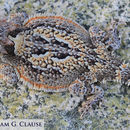en
names in breadcrumbs


The Desert Horned Lizard, Phrynosoma platyrhinos, a member of the Phrynosomatidae family, is a medium-sized flat, and wide lizard. They are measured from snout to vent and reach upwards of 95 mm. Males are generally smaller than females and have post-anal scales, larger femoral pores, and a wider tail base. A characteristic feature of this species is the two central but separate occipital horns that generally project straight back and are noticeably longer than the other spikes on their head. Along their back, several isolated, pointed scales project up and a single row of enlarged, pointed scales line their sides. A row of enlarged, pointed scales also project from each side of the throat (Brennan 2008).
Their unusual appearance is due to unique and integrated set of adaptations. Their camouflaging colors, flat-body form, and sedentary nature make them difficult to see. Their horns and spiny scales make them difficult to swallow. In addition, their pancake shape provides them with a large, flat surface for rapid solar heating, capturing raindrops, or warding off predators. A capacious body provides room for development of numerous eggs and for a large stomach. However, at the same time, their awkward shape limits their speed, which affects their ability to hunt and escape predators. Walking through dense strands of ground-level herbs and grasses make walking difficult for them. Despite these unorthodox strategies with the benefits outweighing the costs, the Desert Horned Lizard continues to survive and reproduce successfully over a broad range (Sherbrooke, 2003).
Native Range: The Desert Horned Lizard has a broad range across the western United States from southeastern Oregon and southwest Idaho down into nearly the entire state of Nevada, northern Utah, southwest California, down into western Arizona and northern Mexico (Cossel, 1997). They have been found in Arizona up to 6,500 feet above sea level (Brennan, 2008).
Habitat and Ecological Associations: Desert Horned Lizards are found in arid regions that have some loose substrate for burrowing such as sand flats with limited vegetation, generally small shrubs such as sagebrush, shadscale, saltbush, or big greasewood with large clear areas separating them. They been found in places with hardpan and gravelly soils, dune systems, dry washes and hillsides with loose soil as well (Cossel, 1997).
Trophic Strategy: Desert Horned Lizards feed predominately on larger ants, making up about 90 percent of their diet. This dietary preference is easily verified by examination of the contents of one of their large and distinctive looking fecal pellets, or scats which contain numerous undigested exoskeletons of ants (Sherbrooke, 2003). They also feed on spiders and insects such as beetles, moth/butterfly larvae (Brennan, 2008).
Behavior/Life cycle: These lizards are diurnal with most of their activity occurring during the morning and evening, taking shelter during the high mid-day temperatures (Brennan, 2008). Once above ground, the horned lizard usually begins to bask by tilting its body and turning its back toward the sun while standing high on extended forelegs or orient a lowered side toward the eastern horizon while elevating its opposite side by extending the legs on that side. The Desert Horned Lizard will also elevate itself on small rises or objects or sits on steep, east-facing slopes or rocks. This directed exposure increases the horned lizard’s body temperature more rapidly because a surface held perpendicular to incoming rays absorb more radiant heat (Sherbrooke, 2003).
Desert Horned Lizards have a seasonal inactivity period, but it varies with local climate. In southern Nevada, they will emerge in March with little adult activity after mid-July. In more southern ranges, they may be active during warm nights, whereas in the north, they bury in substrate (Cossel, 1997). The Desert Horned Lizard is known to have lived at least 8 years in the wild (Sherbrooke, 2003).
Reproduction: Desert Horned Lizards are oviparous (Hallermann). They generally lay one or two clutches of eggs in spring and summer and range from 2-16 eggs (Brennan, 2008). Mating season is from April to June with eggs laid from April to July. Females have 1-2 clutches per year. Incubation period is 50 to 60 days. Individuals reach maturity around 22 months (Cossel, 1997).
Predators: Predators include prairie falcons, loggerhead shrikes, longnose leopard lizards, and striped whipsnakes (Cossel, 1997). Other snake varieties that prey on horned lizards include sidewinders and kestrels.
Functional Adaptations: When threatened, the Desert Horned Lizard immediately flatten their bodies against the soil, hold still, and wait until danger has passed. If the danger is a hawk circling above in the sky, the lizard may tilt its head to keep the enemy in sight and when safe, quickly slip under a shrub for increased protection (Sherbrooke, 2003).
The Desert Horned lizard is more likely to run than other horned lizard species, but often stops under the nearest bush (Brennan, 2008). When frightened into running, horned lizards run a short distance and then stop abruptly. The brief run and sudden stop has reestablished the horned lizard’s first line of defense: invisibility. The predator loses the lizard as it abruptly runs a short distance and then freezes into immobility, and it may never relocate the horned lizard again (Sherbrooke, 2003). Horned lizards can lose their tails, but not easily when grabbed by it, nor do they regenerate a new one if the tip is lost (Sherbrooke, 2003).
Conservation status/management: The Desert Horned Lizard’s status is considered an unprotected nongame species (Cossel, 1997).